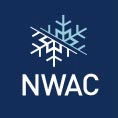Avalanche Forecast
Issued: Feb 10th, 2020 10:00AM
The alpine rating is , the treeline rating is , and the below treeline rating is
Steer around steep slopes with new or recently wind drifted snow at upper elevations. Wind slabs may be found further below ridgelines than usual due to strong winds. Don’t linger on slopes below large cornices.
Summary
Discussion
Use caution before committing to slopes steeper than 35 degrees where you find stiff or textured snow surfaces. Areas near the Cascade crest above treeline have the most snow available for transport as NW winds increase Monday night into Tuesday.
Also at upper elevations near the Cascade crest, cornices have likely grown large over the last storm cycle. Be leery while traveling along ridgelines and don’t linger below slopes with large overhanging cornices.
Forecast Schedule and No Rating definition
We do not have enough specific snowpack information to issue an avalanche hazard rating for the East South zone. However, even when No Rating is applied, applicable avalanche conditions and backcountry travel advice will be provided throughout the season - this forecast is updated every day, all winter long! When weather systems produce very dangerous avalanche conditions in adjacent zones, NWAC will issue an avalanche warning for this zone as well.
Snowpack Discussion
February 6, 2020 (The regional synopsis is updated every Thursday @ 6 pm)
If we could choose one word to sum up the last week, and possibly 2020 in general, that word would be fluid. As of February 6, we are in the midst of yet another atmospheric river event, bringing large amounts of low elevation rain and high elevation snow to our region. The WSDOT-SCR avalanche team relayed that this past January has been the wettest on record at Snoqualmie Pass since precipitation records started in the 80s, and it’s their second wettest month on record. With such potent storms, it’s no surprise that our snowpack and avalanche danger has also been fluid, with fluctuations between high and low danger over short time periods.
February began on the tail end of our largest rain and wind event of the season, with many NWAC weather stations recording wind gusts of over 100 mph and impressive water numbers as high as almost 10 inches in a 48 hour timeframe.
Maximum wind gusts from weather stations in the NWAC Network Friday 1/31 into Saturday 2/1
This event had freezing levels surge to around 8000 feet across the region, introducing rain to a cold dry snowpack at upper elevations for the first time this season. This included rain above 7000 feet in the Washington Pass area, which had largely escaped the wrath of warmer storms up to this point. Dangerous avalanche conditions during this period produced widespread wet avalanches in most zones as large as D3. Along with Loose Wet and Wet Slab avalanches, Cornices failed naturally, and Glide avalanches were observed in multiple zones.
Natural glide avalanche (D2) that occurred on a SE aspect at 4400ft on a convex rock slab between Schriebers Meadow and the Railroad Grade. 02/02/20 Photo: Andrew Kiefer
As the rain finally subsided, cold air flooded our region, allowing the wet snow surface to begin to freeze from the top down. This sharp cooldown created what we are calling the 2/1 crust and allowed for Low danger across the region for a few days. The 2/1 crust varies in thickness but should exist in all areas of the region below ~8000 feet and may be considered as our “new ground”. During this period of low danger, most zones picked up modest amounts of low-density snow to overlay the 2/1 crust and even had a bit of sunshine.
Unfortunately, the period of low danger was short-lived, when two days later, another atmospheric river was on our doorstep. This time, the event started off cooler and had lower projected freezing levels. Many zones in the region were able to pick up a foot or more of new snow in all elevation bands before a switch to rain, with upper elevations receiving multiple feet of snow, creating what we are referring to as the 2/4 interface. The setup of heavy fresh snow over the low-density snow sitting on the 2/1 crust was a great recipe for avalanches on its own. Throw in the switch to rain at low and mid-elevations along with high winds and precip rates, and very dangerous avalanche conditions developed across the map on Wednesday the 5th.
This is where we find ourselves on Thursday, in the middle of a notable avalanche cycle producing wet snow avalanches below the rain line with dry snow avalanches above. The way this winter has been going so far, it’s a good guess that things will continue to be fluid going forward, let’s just hope it’s a colder type of fluid.
Loose Wet avalanche activity on Snoqualmie Pass. 02/05/20. Photo: Andy Harrington
Valid until: Feb 11th, 2020 10:00AM
